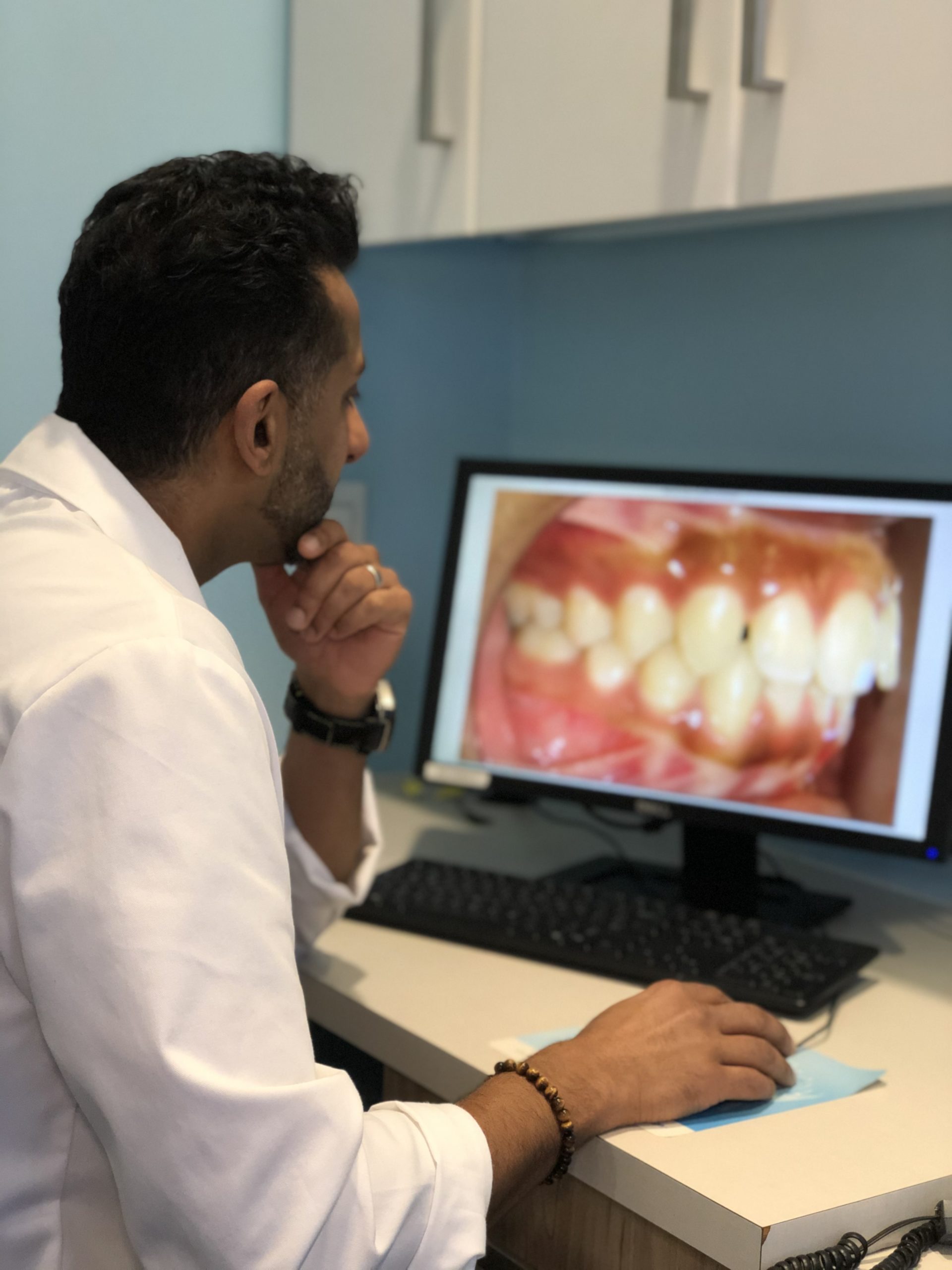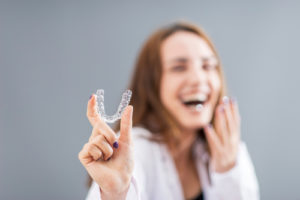
As our Guildford, Scottsdale, and Langley braces patients can tell you, a lot goes into your braces treatment, including significant behind-the-scenes treatment planning. Dr. Vishal Sharma, Dr. Everett Lin, and Dr. Julia Koo, certified specialists in orthodontics, don’t simply glue braces on your teeth and then call it a day.
It takes an in-depth understanding of your dental and facial anatomy, as well as the biomechanics of tooth movement. They rely on their expertise and modern braces appliances to safely and successfully align the teeth and create a functional, healthy bite (the way the upper and lower teeth come together). So, exactly how do braces work to straighten teeth?
In this post, we’ll cover:
- How do braces work?
- How do braces move teeth?
- Do braces and Invisalign work in the same way to straighten teeth?
- What’s the best age for braces?
How Do Braces Work?
Once Dr. Sharma, Dr. Lin, or Dr. Koo examines you and reviews your diagnostic records, they’ll be able to determine an accurate diagnosis and pinpoint how to straighten teeth in a way that will give you the best results. For some patients, braces could be the preferred option. At Aura Orthodontics, we offer several different types of braces, including metal braces and clear braces.
How do braces work? Your Langley or Surrey orthodontist plans out your treatment based on a model of your mouth and, using the model, moves each individual tooth into its ideal place to create a straight smile that complements your unique facial features.
With your customized treatment plan complete, you’ll be ready to get your braces put on. Your orthodontist will stick the braces brackets on your teeth using a special adhesive. These brackets serve almost like handles to grip onto the teeth. The doctor will bend archwires and thread them through the brackets. As the wires try to return to their original shape, they exert gentle pressure and act as a track, moving the teeth along with them.
If we also have to reposition your jaws to correct your bite, we may use auxiliaries like braces rubber bands, too. Rubber bands give us the necessary connective forces to bring the upper and lower arch together for a perfectly aligned bite.
How Do Braces Move Teeth?
As for the mechanics of how braces move teeth, the teeth are attached to your jawbone by your periodontal ligament. When your appliance exerts those continuous, light forces we talked about, one side of the periodontal ligament is compressed and the other side stretches.
The bone on the compressed side loses blood supply and the body’s natural inflammation process kicks in. When this happens, cells called osteoclasts are sent to the area and the bone breaks down. The teeth are free to move where your braces guide them.
On the side of the ligament that’s being stretched, cells called osteoblasts begin to deposit new bone, which forms around the teeth, locking them in place. Eventually, your periodontal ligaments will tighten back up. This process takes time and continues after your braces come off, which is why it’s important to wear a retainer after braces treatment to ensure the teeth don’t shift before they’re secure.
This might sound kind of horrifying, but bone remodeling (bone breaking down and being replaced with new bone) happens all of the time in the body without you knowing it. By precisely manipulating the forces applied to your teeth, your orthodontist ensures the process of straightening your teeth with braces is safe, effective and encourages optimal oral health. How long braces take to get your end results will depend on a number of factors, such as the complexity of your case.
Do Braces and Invisalign Work the Same Way to Straighten Teeth?
If you’re reading this and wondering how to straighten teeth without braces, you’ll be happy to hear that this is a possibility thanks to Invisalign® and Invisalign Teen. When comparing Invisalign vs. braces, patients often want to know if Invisalign works the same way and if it will be as effective as braces.
At Aura Orthodontics, we’ve treated thousands of patients with clear aligners. We can address even complex cases with Invisalign treatment and get the same results we’d achieve with braces.
Invisalign involves a series of custom, clear aligners created according to your Langley or Surrey orthodontist’s specifications. Each set of aligners is slightly different from the set before it and is designed to achieve certain tooth movements. The aligners cover the teeth and use the friction between the aligner and the surface of the teeth to apply gentle force that moves the teeth into place. As you make your way through the series, your new smile gradually takes shape.
For certain types of tooth movements, or to help bring your jaws into alignment, we often also use Invisalign attachments and, sometimes, rubber bands. Invisalign attachments are tooth-colored buttons that are bonded to your teeth. They give the aligners something to grip onto for leverage, while similar to braces rubber bands, Invisalign rubber bands provide connective forces to bring the bite into alignment.
Though teeth move in response to force and bone remodeling still occurs with Invisalign, it’s the application of the force that differs. Unlike braces, which are fixed appliances and stay in place, the aligners are removable. You’ll need to wear your Invisalign aligners for the prescribed amount of time and change them according to plan in order to get the results you want.
What is the Best Age for Braces?
There is no single best age for braces. That said, it’s recommended that children have their first orthodontic evaluation by age 7. At this time, Dr. Sharma, Dr. Lin, and Dr. Koo can see how their bite is shaping up and identify red flags that could require early intervention.
While most kids won’t need early orthodontic treatment, in cases where it is necessary, we can use orthodontic appliances to guide jaw and facial growth and create room for the permanent teeth to erupt properly. This will make braces or Invisalign Teen treatment easier and more affordable down the road, and help to avoid the need for corrective jaw surgery or extractions.
It might seem like every teenager you know has braces and, it’s true, the teenage years are an excellent time to start treatment. Teens are still growing and have faster metabolisms. By harnessing this, we can often move teeth into place more quickly and are still able to correct some problems with the jaw.
However, it’s never too late to get a smile you love! As long as your teeth and gums are healthy, we can move them at any age. In fact, more adults than ever before are seeking out orthodontic treatment. Adult braces and Invisalign will improve the appearance of your smile and boost your confidence. The best part? The benefits of straight teeth are more than just cosmetic. Orthodontic treatment will also improve your oral and overall health, whether you’re in your 20s or your 70s.
Now that you know how braces work to straighten teeth, are you ready to get a smile you’re proud to show off? Schedule a consultation at Aura Orthodontics in Langley or Surrey, BC today!
Dr. Sharma, Dr. Lin, or Dr. Koo will assess your bite, develop a diagnosis, determine how to straighten your teeth using braces or Invisalign, and then create a customized treatment plan. A team member will fill you in everything you need to know, including the cost of braces or clear aligners, what to expect during treatment and how to care for your appliance so you feel confident every step of the way.






